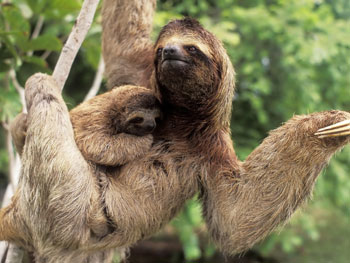- A sloth only comes down from his tree once a week to urinate and defecate on the ground. They dig a hole and covering it afterwards and then head back to the trees where they spend most of their time.
- Sloths typically have small heads, tiny eyes and ears, and a small tail hidden beneath their fur. The rest of its body can be quite large and the arms and legs are powerful, which help with tree climbing. Sloths are tree dwelling mammals that pass their time sleeping and eating.
- There are six different species but most are identified as two or three toed sloths.
- Sloths aren’t as sleepy as once thought—recent studies by Dr. Rattenborg at the Max Planck Institute in Germany indicate they sleep under 10 hours a day.
- Sloths are folivores, herbivores that specialize in eating leaves. Leaves, their primary food source, are not very nutritious, so they have large, slow acting stomachs with multiple compartments with symbiotic bacteria to break down leaves.
- Dead sloths may retain their grip and remain suspended from a branch.
- Sloths are clumsy on land but are very good swimmers. On numerous occasions the Three-Toed Sloth has been known to drop directly from their tree into the water.
- The ancient giant ground sloth grew as big as an elephant.
- Sloths have extra neck vertebrae that allows them to turn their heads some 270 degrees.
- Sloths are related to armadillos and anteaters.
- Sloths are so sedentary that they can actually grow algae on their furry backs, this helps to camouflage the animal in trees.
- Sloths are solitary animals and only come together to mate
- Two-toed sloths spend more time hanging upside-down than their three-toed cousins.
- Sloths don’t get obese—they appear to store extra fat on the pads of their feet.
- Sloths have a very slow metabolism and low body metabolism and can go for days without eating or drinking.
- The Sloth is well known for its title as “slowest animal on Earth”.
- Three-toed sloths are called ais (pronounced "eyes") because of their long, high-pitched call that echoes through the forests as "ahh-e
 eee."
eee." 
References;
http://itotd.com/articles/450/the-hidden-lives-of-sloths/
http://www.thewildclassroom.com/biomes/scientistprofile/scientists/byrson.html
http://uktv.co.uk/eden/item/aid/651079
http://en.wikipedia.org/wiki/Sloth
